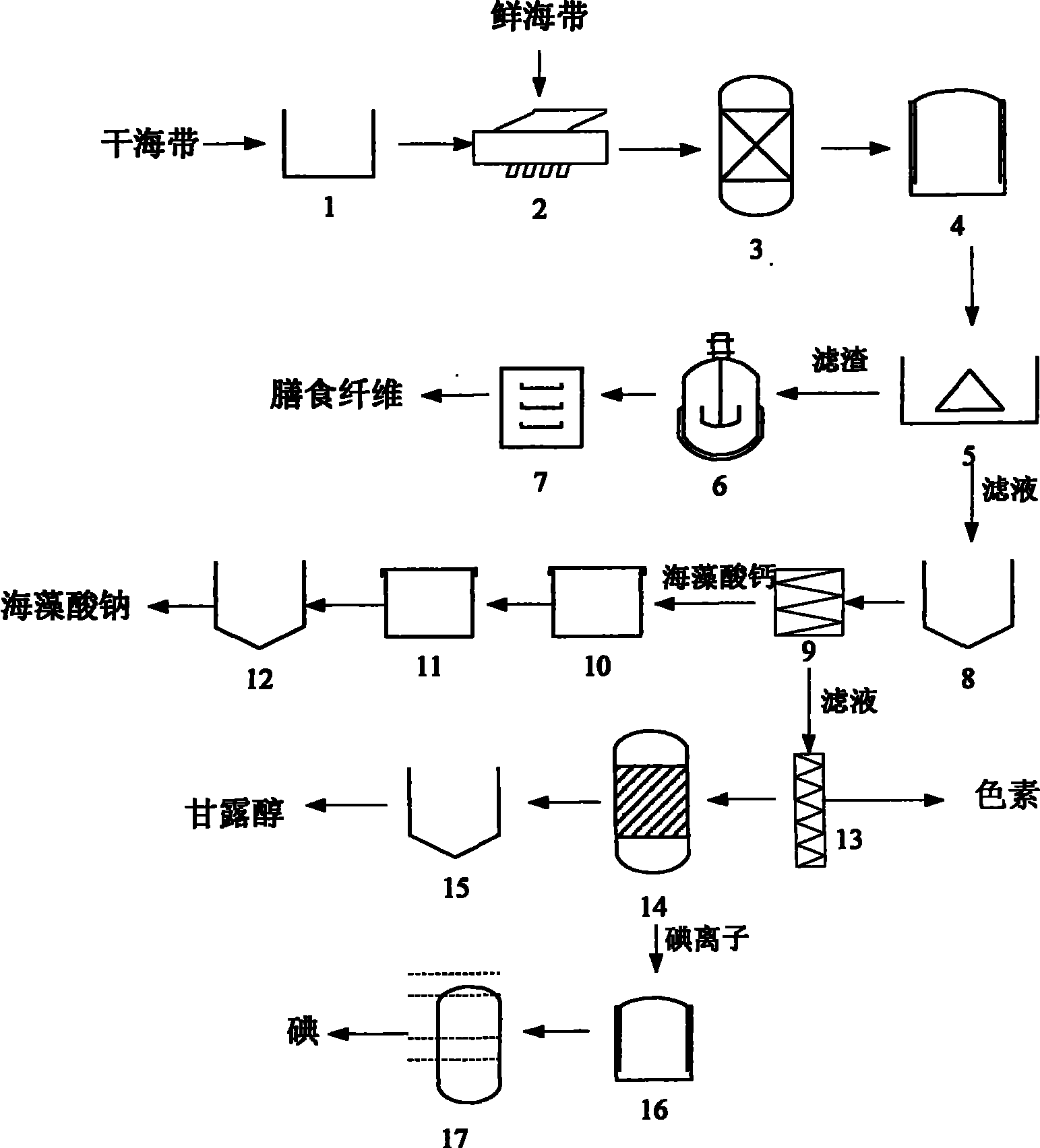Method for preparing various products by separating kelp components and fully using biomass
A biomass and kelp technology, which is applied in the preparation of hydroxyl compounds, organic compounds, food preparation, etc., can solve the problems of high energy consumption, achieve good economic prospects, and shorten the effect of digestion time
- Summary
- Abstract
- Description
- Claims
- Application Information
AI Technical Summary
Problems solved by technology
Method used
Image
Examples
Embodiment 1
[0020] (1) Pretreatment: Wash the fresh kelp with water to remove the sand and cut it into 3-15cm sections;
[0021] (2) steam explosion treatment: carry out steam explosion treatment to the pretreated kelp under 0.6MPa pressure for 5 minutes;
[0022] (3) Digestion: the steam-exploded kelp is digested with 1% sodium carbonate solution 10 times (m / V, g / ml) relative to the dry weight of the kelp, the digestion temperature is 40°C, and the digestion time is 2h;
[0023] (4) Centrifugation: After digestion, add water 20 times (m / V, g / ml) relative to the dry weight of kelp to dilute, and use a tubular centrifuge to centrifuge at a speed of 15000r / min to achieve kelp digested slag and the above Separation of supernatant liquid;
[0024] (5) The kelp digestion residue after centrifugation is mainly kelp fiber, bleached with 0.8% hydrogen peroxide relative to the dry weight of the solid phase material 10 times (m / V, g / ml), the bleaching time is 40min, and the temperature is 35°C. A...
Embodiment 2
[0031] (1) Pretreatment: soak the dried kelp for 1-2 hours, wash off the sand and cut it into 3-15cm sections;
[0032] (2) steam explosion treatment: carry out steam explosion treatment to the pretreated kelp under 0.9MPa pressure for 9 minutes;
[0033] (3) Digestion: the kelp after steam explosion is digested with 2% sodium carbonate solution relative to the dry weight of kelp 14 times (m / V, g / ml), the digestion temperature is 50°C, and the digestion time is 1h;
[0034] (4) Centrifugation: After digestion, add water 13 times (m / V, g / ml) relative to the dry weight of kelp to dilute, and use a tube centrifuge to centrifuge at a speed of 8000r / min to achieve the digestion of kelp and the above Separation of supernatant liquid;
[0035] (5) The kelp digestion residue after centrifugation is mainly kelp fiber, bleached with 2% hydrogen peroxide relative to the dry weight of the solid phase material 12 times (m / V, g / ml), the bleaching time is 20min, and the temperature is 40°C....
Embodiment 3
[0042] (1) Pretreatment: soak the dried kelp for 1 hour, wash off the sand and cut it into 3-15cm sections;
[0043] (2) steam explosion treatment: carry out steam explosion treatment to the kelp after pretreatment under 1.5MPa pressure maintenance pressure 2min;
[0044] (3) Digestion: the kelp after steam explosion is digested with 1.5% sodium carbonate solution relative to the dry weight of kelp 15 times (m / V, g / ml), the digestion temperature is 40°C, and the digestion time is 1h;
[0045] (4) Centrifugation: after digestion, add water 10 times (m / V, g / ml) relative to the dry weight of kelp to dilute, and use a tubular centrifuge to centrifuge at a speed of 14000r / min to achieve kelp digested slag and the above Separation of supernatant liquid;
[0046] (5) The kelp digestion residue after centrifugation is mainly kelp fiber, bleached with 0.7% hydrogen peroxide relative to the dry weight of the solid phase material 20 times (m / V, g / ml), the bleaching time is 50min, and th...
PUM
 Login to View More
Login to View More Abstract
Description
Claims
Application Information
 Login to View More
Login to View More - R&D
- Intellectual Property
- Life Sciences
- Materials
- Tech Scout
- Unparalleled Data Quality
- Higher Quality Content
- 60% Fewer Hallucinations
Browse by: Latest US Patents, China's latest patents, Technical Efficacy Thesaurus, Application Domain, Technology Topic, Popular Technical Reports.
© 2025 PatSnap. All rights reserved.Legal|Privacy policy|Modern Slavery Act Transparency Statement|Sitemap|About US| Contact US: help@patsnap.com

